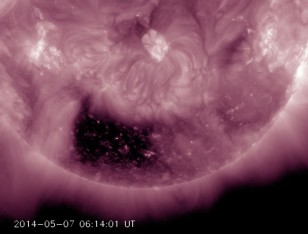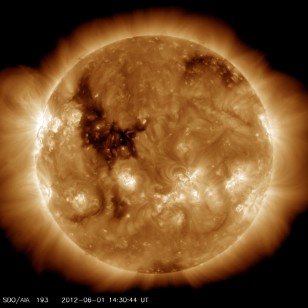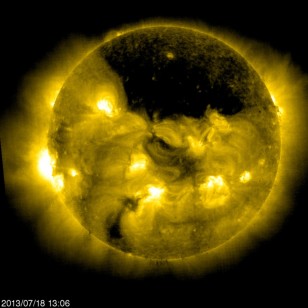
A coronal hole, almost square in its shape, is one of the most noticeable features on the sun of May 5-7, 2014. (NASA)
NASA astronomers recently noticed an odd looking, square shaped hole in the sun.
What they saw is called a coronal hole, something that occurs on a regular basis.
Dean Pesnell, project scientist for the Solar Dynamics Observatory at NASA’s Goddard Space Flight Center in Maryland, says the coronal hole is an area within the corona – the sun’s outer atmosphere – where the coronal material isn’t as dense as its surrounding area.
He adds that these holes don’t extend all the way down to the surface of the sun.
The reason the coronal hole looks like a dark spot on the sun is because it contains little solar material and is lower in temperature than its surroundings.
These holes take a wide variety of shapes including square, triangular, or even in the shape of a rubber chicken, said Pesnell.
He and his colleagues once spotted a coronal hole that resembled a Kokopelli, a Native American fertility symbol of a character playing a flute.
While Pesnell and his colleagues are still investigating what causes them to form, he thinks coronal holes are areas on the sun that were once occupied by sunspots.
As the sunspots fade away, they tend to leave behind magnetic fields that all point in the same direction.
“Sunspots are these areas where you get all of these cool looking loops,” said Pesnell. These coronal loops of magnetic activity that point north or south pour out of the sunspots and join up with either of the sun’s two magnetic poles.
Over time this activity tends to disperse all of the material above it leaving a coronal hole in its place.
Scientists have noted that coronal holes are a normal part of the 11-year solar cycle and tend to pop up during a period when the sun is least active or when it’s at the solar minimum.
During this time, a coronal hole will form over the sun’s North and South Pole and will last for about five years, according to Pesnell.
Last July astronomers spotted a gigantic coronal hole over the sun’s North Pole.
Other coronal holes that pop up on the sun can last from several hours to a couple of weeks or the equivalent of one rotation of the Sun. The sun makes a full rotation about once every 27 days.
Pesnell said that boundaries of the coronal hole will close up as new magnetic fields come up from inside the sun.
Coronal holes also play a role in space weather. Pesnell said that because of the way they’re built, they tend to produce a high-speed solar wind which can be up to three times faster – up to several hundred kilometers per second – than those produced from other areas of the sun, such as where sunspots have formed.
While the fast solar winds produced by a coronal hole don’t tend to have a large impact on Earth, according to Pesnell, they still can hit us and produce Auroras, beautiful displays of light in the skies around the polar regions of the Earth.
Time Lapse Video of Square Coronal Hole (SDO/NASA)
Dr. Dean Pesnell recently appeared on the radio edition of Science World. You can hear the interview here.























My science teacher would love this.
The sun is mean and I hate it cuz it’s hot and cold
Aliens get helium3 from our sun maybe they took too much